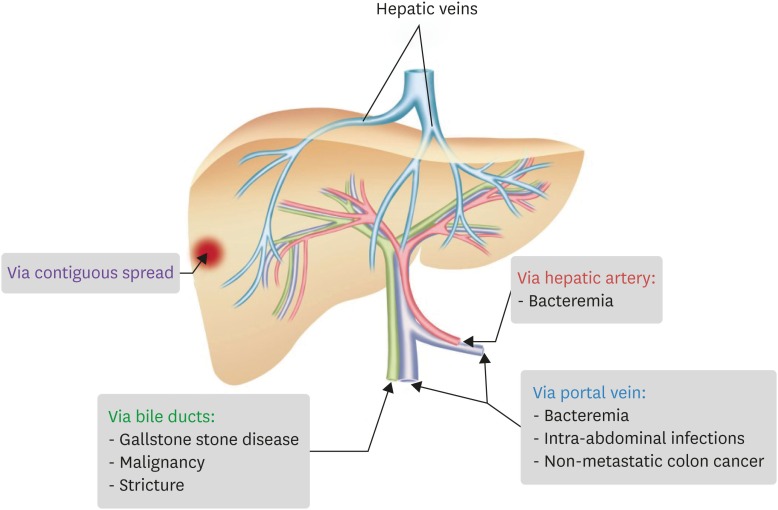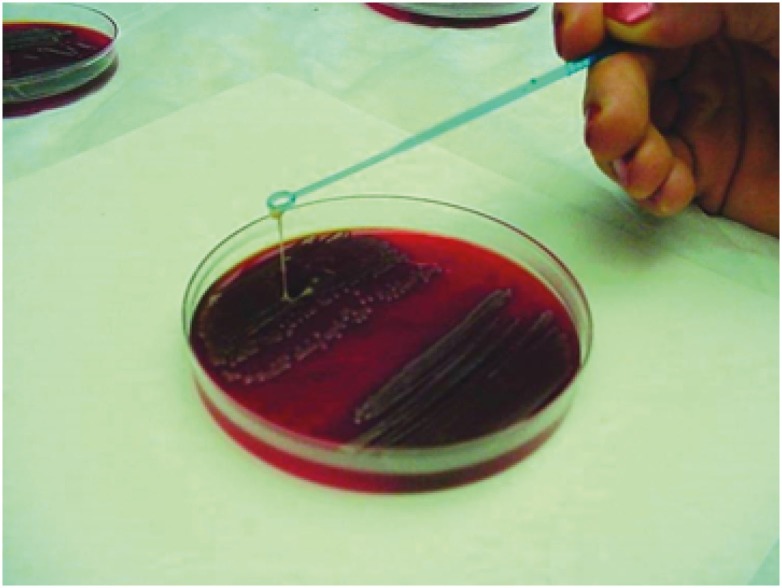1. Cheng DL, Liu YC, Yen MY, Liu CY, Wang RS. Septic metastatic lesions of pyogenic liver abscess. Their association with
Klebsiella pneumoniae bacteremia in diabetic patients. Arch Intern Med. 1991; 151:1557–1559. PMID:
1872659.
2. Liu YC, Cheng DL, Lin CL.
Klebsiella pneumoniae liver abscess associated with septic endophthalmitis. Arch Intern Med. 1986; 146:1913–1916. PMID:
3532983.
3. Wang JH, Liu YC, Lee SS, Yen MY, Chen YS, Wang JH, Wann SR, Lin HH. Primary liver abscess due to Klebsiella pneumoniae in Taiwan. Clin Infect Dis. 1998; 26:1434–1438. PMID:
9636876.
4. Chung DR, Lee SS, Lee HR, Kim HB, Choi HJ, Eom JS, Kim JS, Choi YH, Lee JS, Chung MH, Kim YS, Lee H, Lee MS, Park CK. Korean Study Group for Liver Abscess. Emerging invasive liver abscess caused by K1 serotype
Klebsiella pneumoniae in Korea. J Infect. 2007; 54:578–583. PMID:
17175028.
5. Siu LK, Yeh KM, Lin JC, Fung CP, Chang FY.
Klebsiella pneumoniae liver abscess: a new invasive syndrome. Lancet Infect Dis. 2012; 12:881–887. PMID:
23099082.
6. Turton JF, Englender H, Gabriel SN, Turton SE, Kaufmann ME, Pitt TL. Genetically similar isolates of
Klebsiella pneumoniae serotype K1 causing liver abscesses in three continents. J Med Microbiol. 2007; 56:593–597. PMID:
17446279.
7. Sifri CD, Madoff LC. Infections of the Liver and Biliary System (Liver Abscess, Cholangitis, Cholecystitis). In : Bennett JE, Dolin R, Blaser MJ, editors. Mandell, Douglas, and Bennett's Principles and Practice of Infectious Diseases. 8th ed. Philadelphia: Elsevier Saunders;2015. p. 960.
8. Mavilia MG, Molina M, Wu GY. The evolving nature of hepatic abscess: a review. J Clin Transl Hepatol. 2016; 4:158–168. PMID:
27350946.

9. Hansen PS, Schønheyder HC. Pyogenic hepatic abscess. A 10-year population-based retrospective study. APMIS. 1998; 106:396–402. PMID:
9548429.

10. Pang TC, Fung T, Samra J, Hugh TJ, Smith RC. Pyogenic liver abscess: an audit of 10 years' experience. World J Gastroenterol. 2011; 17:1622–1630. PMID:
21472130.

11. AbdelRafee A, El-Shobari M, Askar W, Sultan AM, El Nakeeb A. Long-term follow-up of 120 patients after hepaticojejunostomy for treatment of post-cholecystectomy bile duct injuries: a retrospective cohort study. Int J Surg. 2015; 18:205–210. PMID:
25965917.

12. Peng YC, Lin CL, Sung FC. Risk of pyogenic liver abscess and endoscopic sphincterotomy: a population-based cohort study. BMJ Open. 2018; 8:e018818.

13. Qian Y, Wong CC, Lai S, Chen H, He X, Sun L, Wu J, Zhou J, Yu J, Liu W, Zhou D, Si J. A retrospective study of pyogenic liver abscess focusing on
Klebsiella pneumoniae as a primary pathogen in China from 1994 to 2015. Sci Rep. 2016; 6:38587. PMID:
27929082.

14. Tu YC, Lu MC, Chiang MK, Huang SP, Peng HL, Chang HY, Jan MS, Lai YC. Genetic requirements for
Klebsiella pneumoniae-induced liver abscess in an oral infection model. Infect Immun. 2009; 77:2657–2671. PMID:
19433545.
15. Lin YT, Siu LK, Lin JC, Chen TL, Tseng CP, Yeh KM, Chang FY, Fung CP. Seroepidemiology of
Klebsiella pneumoniae colonizing the intestinal tract of healthy Chinese and overseas Chinese adults in Asian countries. BMC Microbiol. 2012; 12:13. PMID:
22260182.

16. Chung DR, Lee H, Park MH, Jung SI, Chang HH, Kim YS, Son JS, Moon C, Kwon KT, Ryu SY, Shin SY, Ko KS, Kang CI, Peck KR, Song JH. Fecal carriage of serotype K1
Klebsiella pneumoniae ST23 strains closely related to liver abscess isolates in Koreans living in Korea. Eur J Clin Microbiol Infect Dis. 2012; 31:481–486. PMID:
21739348.
17. Smith GW, Blackwell CC, Nuki G. Faecal flora in spondyloarthropathy. Br J Rheumatol. 1997; 36:850–854. PMID:
9291853.

18. Thom BT. Klebsiella in faeces. Lancet. 1970; 2:1033.
19. Yang CC, Yen CH, Ho MW, Wang JH. Comparison of pyogenic liver abscess caused by non-
Klebsiella pneumoniae and
Klebsiella pneumoniae. J Microbiol Immunol Infect. 2004; 37:176–184. PMID:
15221038.
20. Chan KS, Yu WL, Tsai CL, Cheng KC, Hou CC, Lee MC, Tan CK. Pyogenic liver abscess caused by
Klebsiella pneumoniae: analysis of the clinical characteristics and outcomes of 84 patients. Chin Med J (Engl). 2007; 120:136–139. PMID:
17335656.
21. Lin JC, Siu LK, Fung CP, Tsou HH, Wang JJ, Chen CT, Wang SC, Chang FY. Impaired phagocytosis of capsular serotypes K1 or K2
Klebsiella pneumoniae in type 2 diabetes mellitus patients with poor glycemic control. J Clin Endocrinol Metab. 2006; 91:3084–3087. PMID:
16720670.
22. Sheu SJ, Kung YH, Wu TT, Chang FP, Horng YH. Risk factors for endogenous endophthalmitis secondary to
Klebsiella pneumoniae liver abscess: 20-year experience in Southern Taiwan. Retina. 2011; 31:2026–2031. PMID:
21499189.
23. Lin YT, Liu CJ, Yeh YC, Chen TJ, Fung CP. Ampicillin and amoxicillin use and the risk of
Klebsiella pneumoniae liver abscess in Taiwan. J Infect Dis. 2013; 208:211–217. PMID:
23568176.
24. Paczosa MK, Mecsas J.
Klebsiella pneumoniae: Going on the dffense with a strong defense. Microbiol Mol Biol Rev. 2016; 80:629–661. PMID:
27307579.
25. Su SC, Siu LK, Ma L, Yeh KM, Fung CP, Lin JC, Chang FY. Community-acquired liver abscess caused by serotype K1
Klebsiella pneumoniae with CTX-M-15-type extended-spectrum beta-lactamase. Antimicrob Agents Chemother. 2008; 52:804–805. PMID:
18056273.
26. Pan YJ, Fang HC, Yang HC, Lin TL, Hsieh PF, Tsai FC, Keynan Y, Wang JT. Capsular polysaccharide synthesis regions in
Klebsiella pneumoniae serotype K57 and a new capsular serotype. J Clin Microbiol. 2008; 46:2231–2240. PMID:
18508935.
27. Brisse S, Passet V, Haugaard AB, Babosan A, Kassis-Chikhani N, Struve C, Decré D. wzi Gene sequencing, a rapid method for determination of capsular type for
Klebsiella strains. J Clin Microbiol. 2013; 51:4073–4078. PMID:
24088853.
28. Struve C, Roe CC, Stegger M, Stahlhut SG, Hansen DS, Engelthaler DM, Andersen PS, Driebe EM, Keim P, Krogfelt KA. Mapping the evolution of hypervirulent
Klebsiella pneumoniae
. MBio. 2015; 6:e00630. PMID:
26199326.

29. Lin JC, Chang FY, Fung CP, Xu JZ, Cheng HP, Wang JJ, Huang LY, Siu LK. High prevalence of phagocytic-resistant capsular serotypes of
Klebsiella pneumoniae in liver abscess. Microbes Infect. 2004; 6:1191–1198. PMID:
15488738.
30. Yu VL, Hansen DS, Ko WC, Sagnimeni A, Klugman KP, von Gottberg A, Goossens H, Wagener MM, Benedi VJ. International Klebseilla Study Group. Virulence characteristics of
Klebsiella and clinical manifestations of
K. pneumoniae bloodstream infections. Emerg Infect Dis. 2007; 13:986–993. PMID:
18214169.
31. Hsu CR, Lin TL, Chen YC, Chou HC, Wang JT. The role of
Klebsiella pneumoniae rmpA in capsular polysaccharide synthesis and virulence revisited. Microbiology. 2011; 157:3446–3457. PMID:
21964731.
32. Miethke M, Marahiel MA. Siderophore-based iron acquisition and pathogen control. Microbiol Mol Biol Rev. 2007; 71:413–451. PMID:
17804665.

33. Chen SC, Wu WY, Yeh CH, Lai KC, Cheng KS, Jeng LB, Wang PH, Lin DB, Chen CC, Lee MC, Bell WR. Comparison of
Escherichia coli and
Klebsiella pneumoniae liver abscesses. Am J Med Sci. 2007; 334:97–105. PMID:
17700198.
34. Lee SS, Chen YS, Tsai HC, Wann SR, Lin HH, Huang CK, Liu YC. Predictors of septic metastatic infection and mortality among patients with
Klebsiella pneumoniae liver abscess. Clin Infect Dis. 2008; 47:642–650. PMID:
18643760.
35. Lin AC, Yeh DY, Hsu YH, Wu CC, Chang H, Jang TN, Huang CH. Diagnosis of pyogenic liver abscess by abdominal ultrasonography in the emergency department. Emerg Med J. 2009; 26:273–275. PMID:
19307388.

36. Alsaif HS, Venkatesh SK, Chan DS, Archuleta S. CT appearance of pyogenic liver abscesses caused by
Klebsiella pneumoniae
. Radiology. 2011; 260:129–138. PMID:
21460028.
37. Maffiolo C, Novellas S, Chevallier P, Brunner P, Mourou MY, Bruneton JN. Thrombophlebitis of the hepatic veins: complication of a
Klebsiella liver abscess. Clin Imaging. 2006; 30:63–65. PMID:
16377489.
38. Binder MI, Chua J, Kaiser PK, Procop GW, Isada CM. Endogenous endophthalmitis: an 18-year review of culture-positive cases at a tertiary care center. Medicine (Baltimore). 2003; 82:97–105. PMID:
12640186.
39. Jackson TL, Eykyn SJ, Graham EM, Stanford MR. Endogenous bacterial endophthalmitis: a 17-year prospective series and review of 267 reported cases. Surv Ophthalmol. 2003; 48:403–423. PMID:
12850229.

40. Jung H, Kim SW, Chang HH, Lee SA, Kim Y, Hwang S, Kim SJ, Lee JM. Analysis of Klebsiella as a prognostic factor of ocular outcomes in endogenous endophthalmitis with decision tree analysis. [Epub ahead of print]. Infect Chemother. 2018; 50:238–251.
41. Cheng HP, Siu LK, Chang FY. Extended-spectrum cephalosporin compared to cefazolin for treatment of
Klebsiella pneumoniae-caused liver abscess. Antimicrob Agents Chemother. 2003; 47:2088–2092. PMID:
12821451.
42. Hsieh HF, Chen TW, Yu CY, Wang NC, Chu HC, Shih ML, Yu JC, Hsieh CB. Aggressive hepatic resection for patients with pyogenic liver abscess and APACHE II score > or =15. Am J Surg. 2008; 196:346–350. PMID:
18718219.
43. Chee SP, Ang CL. Endogenous
Klebsiella endophthalmitis--a case series. Ann Acad Med Singapore. 1995; 24:473–478. PMID:
7574438.
44. Chou FF, Kou HK. Endogenous endophthalmitis associated with pyogenic hepatic abscess. J Am Coll Surg. 1996; 182:33–36. PMID:
8542086.







 PDF
PDF ePub
ePub Citation
Citation Print
Print



 XML Download
XML Download